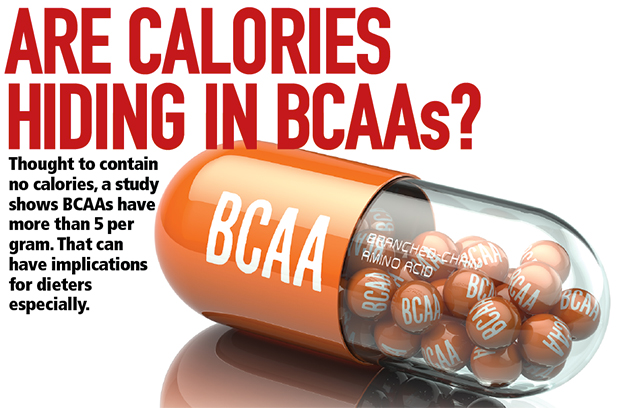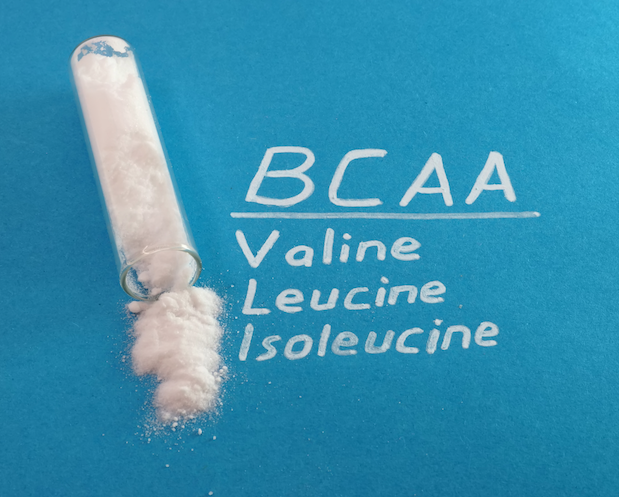Are Calories Hiding in BCAAs?

Thought to contain no calories, study shows BCAAs have more than 5 per gram
In sports nutrition, to gain muscle or lose fat, it’s critical to understand how many calories one’s consuming daily. In other words, we learn that calories count when looking to achieve a physique or a physical goal. Food products contain Nutrition Fact panels, while supplements use a Supplement Facts panel. These panels help explain to the consumer just how many calories are in the product, along with the macronutrient breakdown (carbohydrates, proteins, fats) with information on selected other nutrients. If knowing your caloric intake is important to you, then also knowing what contributes to the caloric load is paramount.
In school and even in university life, we’re taught that our calories come from carbohydrates (i.e., foods such as bread, cereals, potatoes, fruit, vegetables), proteins (fish, steak, chicken, eggs, etc.), and fats (from foods such as butter, oils, nuts, seeds, dressings, etc.). However, are these macronutrient components the only things that contribute calories to our diet and waistline? This question, coupled with the growing popularity of branched-chain amino acids in sports and human performance, garnered my interest. In other words, considering that so many of these BCAA products claim nocaloric value, I wanted to know if this claim was actually true.
In partnership with Covance, a leading independent testing laboratory, we analyzed the contents of one popular BCAA product from NutraBio for caloric value, along with the potential macronutrient makeup of the BCAAs and more. We wanted to characterize this BCAA product as to get to better know the category.

The BCAAs are typically thought of as leucine, isoleucine, and valine. These special amino acids are preferentially metabolized in muscle tissue. Further, the amino acid leucine is thought to be the only amino acid to stimulate muscle-protein synthesis. Stimulating muscle-protein synthesis is one key to muscle remodeling, and with all things being equal, one of the mechanisms by how one gains muscle. Research has shown that BCAA supplementation in athletes is associated with reduced muscle soreness (less delayed-onset muscle soreness), contributes toward hydration (as these are typically in powder form and mixed with water for drinking), stimulates muscle-protein synthesis, and aids in reducing muscle loss during times of reduced caloric intake (while dieting or cutting weight). All of these are important aspects for an athlete concerned with recovery and wellness.
As stated above, typical BCAA products claim on their labels to have no caloric value. So let’s take a look at how we measured the NutraBio BCAA Natural product and what the results mean.
One way to measure the caloric value of any food or beverage is by bomb calorimetry. In essence, this process measures the heat given off after the foodstuff is combusted in a sealed chamber. The heat given off is energy that can also be expressed as the caloric value per gram of food. In our bomb calorimetry tests, the NutraBio BCAA Natural came in with a caloric value of 5.35 calories per gram of product. In other words, for every 5 grams (1 teaspoon) of this BCAA product, you get 21.40 calories.

In addition to direct bomb calorimetry, standard analysis to determine the carbohydrate, protein, and fat aspects along with the free amino-acid makeup, moisture levels, and fibre content were also analyzed. We employed the standard universal AOAC methods and other validated means to determine these parameters.
In other words, to truly learn the makeup of BCAA powder, we employed analytical techniques of chemical and direct testing. As an aside, it’s important to know that the NutraBio BCAA Natural product is claimed to contain zero calories along with 2.5 grams of leucine, 1.25 grams of isoleucine, and 1.25 grams of valine. This is the often-marketed 2:1:1 ratio of leucine to its sister BCAAs.
In revisiting part of the motivation to undertake this analysis, it’s important to understand that if you’re watching your weight for any reason, knowing how much you’re ingesting (calorie-wise) as well as your caloric expenditure amounts is one of the keys to achieving your goal. So imagine if you’re strictly dieting and eating clean, working your butt off for a goal, but you’re not yet achieving it? In this instance, if you were ingesting the BCAA product once or even a few times per day and thought they had no caloric value as BCAAs aren’t an intact protein, you’d be wrong. These contribute calories to your daily diet and should be counted for your overall intake.
After analysis and reanalysis, Covance Laboratories and I determined the following about this BCAA powdered product:
NutraBio BCAA Natural (powder):
- 5.35 calories per gram (by direct bomb calorimetry analysis)
 26.75 calories per 5 g serving (by direct bomb calorimetry)
26.75 calories per 5 g serving (by direct bomb calorimetry)- 0.123 fat calories per 5 g (by chemical analysis)
- 0.062 to 1.57 carbohydrate calories per 5 g (by chemical analysis)
- <0.0375 fibre calories (by chemical analysis)
- 3.41 protein calories per gram (by chemical analysis)
- Leucine: 2.390 grams per 5 g serving
- Isoleucine: 1.190 grams per 5 g serving
- Valine: 1.240 grams per 5 g serving
Note: Minuscule amounts of alanine, tyrosine, and lysine were also found in the product, which, notably, is marked BCAA (only) and not as containing a spectrum of amino acids.
So what did we learn by conducting these series of tests and analysis? The answer is both obvious and not obvious. “Obvious” includes now knowing this particular BCAA product at least contains and contribute calories to the diet. First, we learn that per teaspoon (5 grams), this particular product provides 5.35 grams, demonstrating that a non-intact protein (an incomplete protein) can contribute calories to the diet. Surprisingly enough, the analysis also demonstrated the product to contain (naturally?) a little carbohydrate and to be pretty true to label in terms of its amounts of leucine, isoleucine, and valine. The goal of this communication is to share information with you that may be useful in your own exercise and eating strategies for obtaining your physique or performance goals.
To follow Dr.Douglas Kalman, visit: http://www.linkedin.com/in/douglaskalmanphdrd http://twitter.com/dougkalmanphdrd Reference: Covance – Substantiation Sciences Analysis – Report 2167630-0, June 25, 2018.
